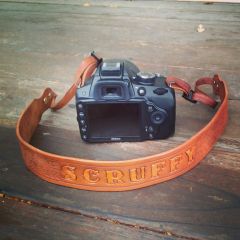-
Posts
961 -
Joined
-
Last visited
Content Type
Profiles
Forums
Events
Blogs
Gallery
Everything posted by BDAZ
-

Order Process Of Belt Making. Question About Dying.
BDAZ replied to zaynexpetty's topic in How Do I Do That?
Just one tip. A lot of my projects are medium to dark brown and lined with suede. I will glue and trim the lining and then dye using an airbrush, and oil, trim to final size, then cut the groove for the thread. Since the item is trimmed the groove will be spaced perfectly on top an bottom of the item. A belt or strap is just grooved on the top. The groove is useful as a sewing guide but is much lighter than the item. I found brown Sharpies at Staples, both fine and standard tips. I will run the fine Sharpie in the groove and then use the standard for any touch ups. I then use a heavy application of a water based finish coat which also allows me to semi wet form the item, then dry in the AZ sun. I then do my edge which can include beveling and edge paint OR using a large black marker followed by the application of a blend of soy and bees wax and a buff with a Tandy edge stick or a burnish on the drill press. The a bit more oil, and a final coat of a spray on leather lacquer and final drying in the sun. The oil step includes serious rubbing with sheep scrap, which removes any excess dye. I have not used Resolene but will give that a try today. YMMV Bob -
This can't be used with 3/4 inch letters without major modification. Cya! Bob
-
Freakin Brilliant! Since all my names are vertical, the I is always a bear. I am getting it perfect now but with lots of effort. Your way I can have all the letters pressed tight and aligned, then tap an initial impression or maybe use a steel bar on the arbor press, then go back and arbor each individual letter. I'm going to do some testing later toda. Thanks! Bob
-
Me too. Thanks!
-

Question On Stoned Oil Cowhide
BDAZ replied to Leprechaunleather's topic in Leatherwork Conversation
This is a scrap with some test stamping and half dyed with vinegaroon. The leather was dark brown. Cya! Bob -

Question On Stoned Oil Cowhide
BDAZ replied to Leprechaunleather's topic in Leatherwork Conversation
Definitely can't dye it BUT initial tests with vinegaroon look promising. Stamping effect is minimal but it does appear to hold unless the item is stretched. Cya! Bob -

Question On Stoned Oil Cowhide
BDAZ replied to Leprechaunleather's topic in Leatherwork Conversation
I was working with some this morning. It is relatively stretchy and I doubt it would be useful for wallets. When you stretch it, the color lightens. I used it to make some repairs on a 50 year old carved leather guitar strap as the color matched was was originally natural. I did test it with an attempt to case it and use stamps. It did take stamps with some serious pounding. I bought it for use on a friends skiff he is building. It looks like it will handle weather and water well. Might be good for shoes, sandals, etc. Hope that helps. Cya! Bob -
Well, standard road warrior behavior. I have bins full of almost perfect bags. The Maxpedition is the best to date. I always plan to be stuck somewhere for a few days in a place that I can't speak the language. I carry 5TBs of media. Have fun! Bob
-
Wow, Germany seems to be a treasure trove for you of sewing machine ephemeris! Tschuess! Bob
-
I have a similar issue with the lined cases I make. Instead of using a ruler, I purchased some narrow aluminum stock at Home Depot and use that as a straight edge, It allows me to get the straight on the item with much better traction than a wider ruler. I have roughed up one side for better traction. I use a utility knife which I strop often and that seems to give me a very good edge.I use a rotary cutter for cutting fabrics and suede. Cya! Bob
-
I just received my 3200 a few weeks ago and I am over the moon. Bob was a super star and the machine does exactly what is it supposed to do. I bought my first piece of scrap from Tandy a month or so ago and now I am shipping product all over the world. Could do it without the Cowboy, and again, Bob is a pleasure to deal with. I don't nee dthe capabilities of the 4500 but the 3200 is quite similar and a bit more affordable. Good luck and have fun! Bob
-
Well these are the standard Tandy Celtic Stamps. I think, with a good deep impression one could paint the whole stamp, possibly using a mask, then carefully wipe the dye or stain off the top of the knots. Cya! Bob
-
Welcome Deni. I am also a newbiw but have made great progress, with much help from this website. I travel extensively (50,000-100,000 annually) and while I didn't use leather, I came up with a system of using brightly colored nylon pouches to store my various items. I am a musician and I always carry noise cancelling headphones, additional audio gear for my laptop and tablet, a 4 track recorder, all kinds of computer accessories, personal items, a Garmin handheld GPS, and other accessories to make life at 40K feet more productive. Green is personal, Day glo is "Do not leave in the lounge" and is for power supplies, tablet, yellow is audio, purple is computer and red is misc. When I use an item in flight, I keep the pouch visible in the seat pocket so If there's an empty pouch, I look for the contents when I pack up. I used to lose cameras, GPSs, earphones, you name it. Since I started the system I haven't lost a single item. In addition, I remove the Master pouches when going through security and I never have my bags searched. My bag is a Maxpedition tactical bag which will fit under the seat of every plane, including commuters. I usually carry one or two instruments so a small compact bag is essential.You could make a version in leather. You could possibly use colored leather instead of nylon. I hope this gives you some ideas? Cya! Bob
-
"Thankfully I was able to use the "1" from my number set as a place holder" OK! That got me thinking. Of course it's not a problem with horizontal names or words BUT it's the vertical ones... Maybe I'll try using any letter as a spacer and then leaving the I for last and centering it between the other two letters or do it manually with a mallet.. I use the ram foot which pretty much covers the I but I may cut down a standard handle to an inch or so for the &^%$# I. Hopefully I'll never have a commission with skiing or Hawaii on it! Maybe I'll charge extra to cover the remakes on names with I on them. Cya! Bob Update: I used another letter as a marker, created the name without the I then pounded it in manually and Voila! Perfect! Time consuming. Most of my work is with the Celtic alphabet, no longer in production so an extra letter wont help.
-
I have found the combination sander very useful for all types of leather tasks, sanding edges even, skiving, sanding forms for wet molding, sharpening punches, cleaning up alphabet punches and many other tasks. Cya! Bob
-
I make a product which has a vertical name centered in a 2" strip and it's a bear getting it centered, spaced and vertical. The worst is the %^&(*$ "I". It's narrower then all the other letters and a bear to keep vertical. I find the middle point, then use a fence on the arbor press with an aluminum triangle and a centering rule to make sure the first letter is both centered and square to the edge. Once the first letter, (the middle one or close) is done, I keep the stamp in the impression and build the name from center out. This generally works well EXCEPT for the "I". I usually come close but I have yet to get the "I" perfect. Cya! Bob
-
Once you the hang of it, it should only take a few minutes with one of those things. Seconds! Cya! Bob
-
I also have had trouble but my new skiver works like a champ! Cya! Bob
-
Check out the Cowboy 3200: http://www.tolindsewmach.com/cb3200.html I received mine a few weeks ago and i am thrileld with it. It costs LESS than the used machine you are looking at and uses all the accessories of the 4500. It comes WITH the servo motor, and I ordered it with the stand from the 4500. Cya! Bob
-
Just a hunch but you may want to contact the suppliers and see if they have any expired unexposed film. Cya Bob
-
I have had good luck with these sprayers while I am shopping for a decent air brush system: They are available at Home Depot, and extra jars and sprayers are available separately, Cya! Bob
-

Resisting Black Oil Dye
BDAZ replied to TomG's topic in Dyes, Antiques, Stains, Glues, Waxes, Finishes and Conditioners.
I did some tests this evening using liquid latex as a resist for Feibings Oil Stain. I have been having trouble getting any of the standard water based resists to work. The letters used were 3/4 inch and 1/2 inch. In the test the L and the E still have the latex in place. The T was painted with Block out first, then latex. The first B was treated with Mop and Glo, the second B with Block out and the O with Mop and Glo plus latex. I used 3 heavy applications of full strength oil dye using a wool applicator. I intentionally rubbed the letters quite aggressively during the application. I suspect that due to the low viscosity of the dye, it will have a tendency to seep under the edges of where the latex is applied. The latex is easily removed by rubbing a finger over it and then pulling it up. I assume it would work really well with larger objects where the seepage would not be so noticeable. Cya! Bob -
-
Has anyone used the plastic vacuum clothes bags? I would think a piece of ply with the item on it my do the trick? Cya! Bob
- 23 replies





